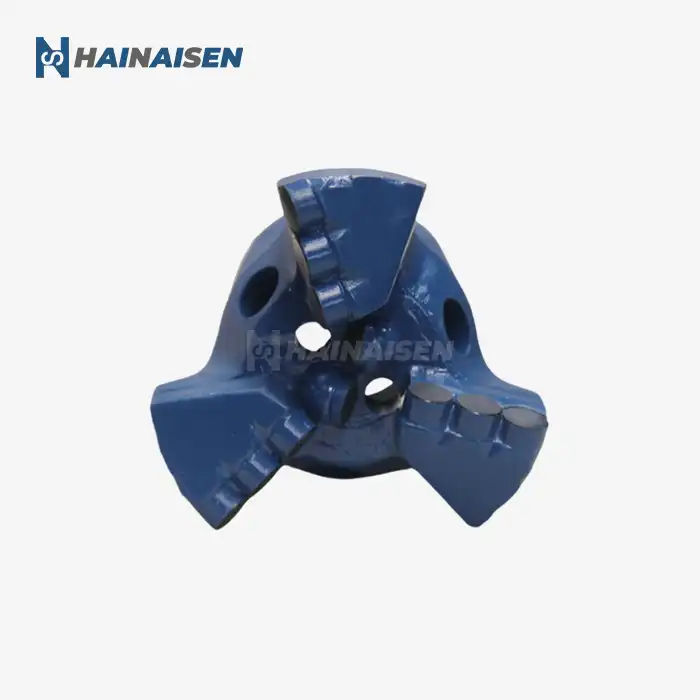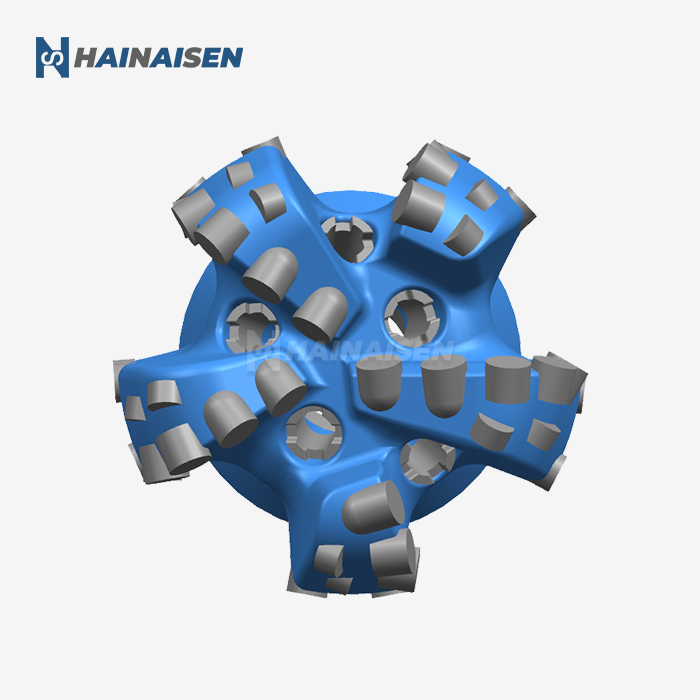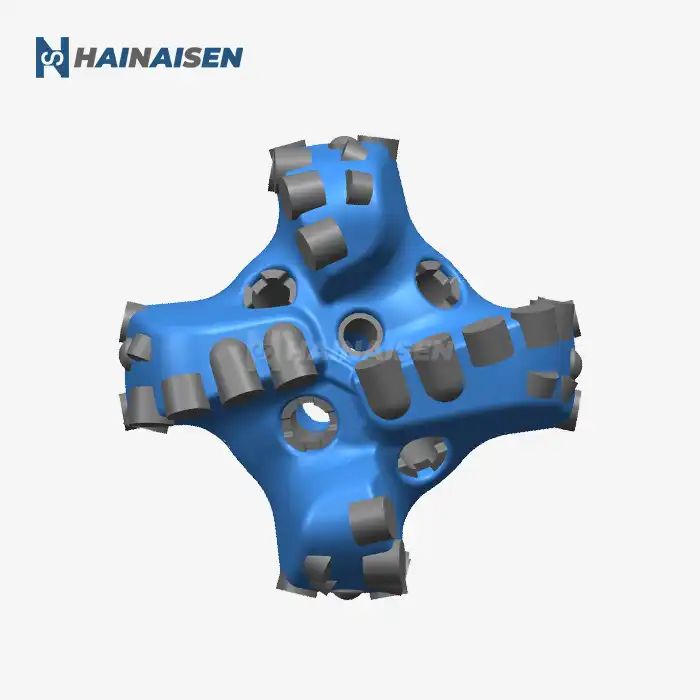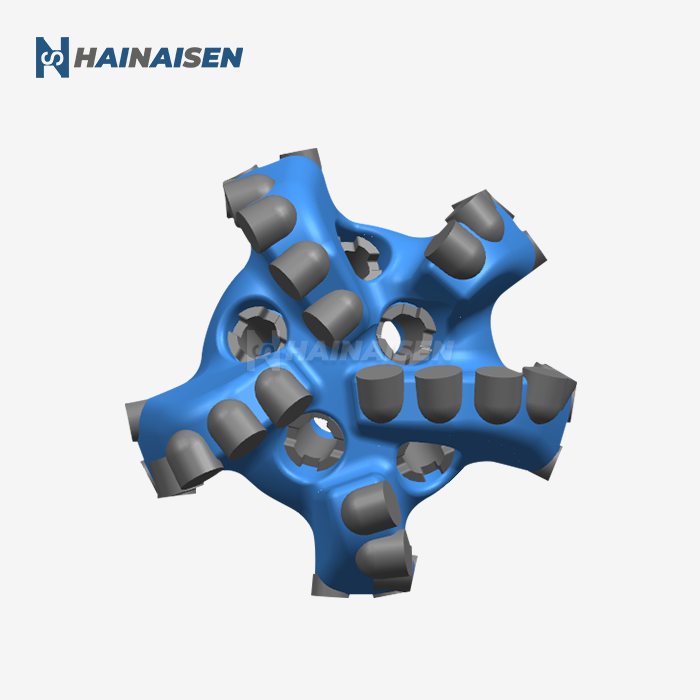Core Mechanics: How Four Blades Enhance Drilling Efficiency?
The Four Blade Wing High Performance Petroleum Drill Bit represents a significant leap forward in drilling technology. Its unique design incorporates several key features that contribute to its superior performance:
Optimized Blade Configuration
The four-blade layout is carefully engineered to maximize cutting efficiency while minimizing vibration. This configuration allows for a more even distribution of force during drilling, resulting in smoother operation and reduced wear on the bit. The strategic placement of the blades also enhances the bit's ability to maintain a straight borehole, which is crucial for maintaining drilling accuracy and reducing the likelihood of costly deviations.
Advanced Cutter Technology
These drill bits utilize state-of-the-art PDC (Polycrystalline Diamond Compact) cutters, which offer unparalleled hardness and wear resistance. The cutters are precisely positioned on the blades to optimize rock removal and chip evacuation. This advanced cutter technology contributes significantly to the bit's ability to maintain high penetration rates even in challenging formations.
Hydraulic Optimization
One of the key factors in drilling efficiency is the ability to effectively remove cuttings from the borehole. The four-blade design incorporates sophisticated hydraulic channels that facilitate efficient fluid flow. This enhanced hydraulic performance ensures that cuttings are quickly evacuated, preventing bit balling and maintaining optimal cutting surface exposure. The result is sustained high penetration rates and extended bit life.
Stability Enhancement Features
Drilling stability is crucial for maintaining consistent performance and preventing damage to both the bit and the drillstring. Four-blade bits often incorporate stability-enhancing features such as tapered gauge pads and secondary cutting structures. These elements work together to reduce lateral vibrations and maintain a smooth drilling operation, even in formations with varying hardness.
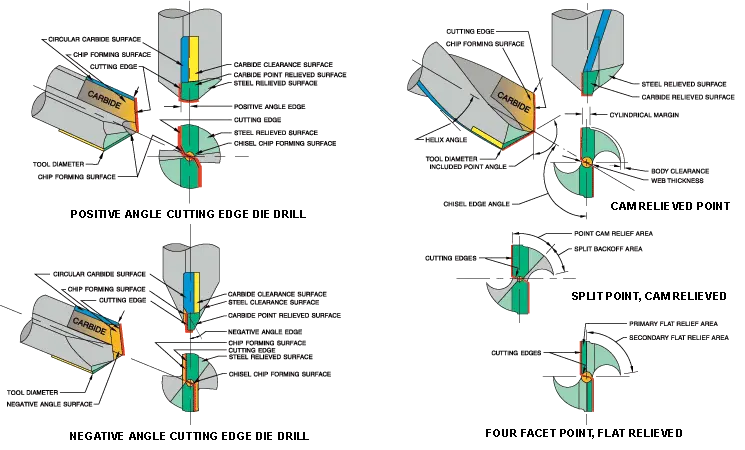
Comparative Analysis: Four-Blade vs Traditional Drill Bits
To truly appreciate the advantages of the Four Blade Wing High Performance Petroleum Drill Bit, it's essential to compare it with traditional drill bit designs:
Penetration Rate
Four-blade bits generally offer superior penetration rates compared to traditional three-blade or six-blade designs, especially in medium hardness formations. The optimized blade configuration allows for more aggressive cutting action without sacrificing stability. This translates to faster drilling progress and reduced overall project time.
Durability and Bit Life
The advanced materials and design of four-blade bits contribute to exceptional durability. While traditional bits may require frequent replacements due to wear, four-blade bits can maintain their cutting efficiency for extended periods. This increased bit life leads to fewer tripping operations, reducing non-productive time and associated costs.
Stability and Vibration Control
Four-blade bits excel in providing a balanced drilling operation with reduced vibration. Traditional bits, particularly those with fewer blades, may be more prone to whirl and lateral vibrations, especially in varying formations. The enhanced stability of four-blade bits results in straighter boreholes and less damage to the drillstring components.
Versatility Across Formations
While specialized bits may be optimal for specific formation types, four-blade bits offer impressive versatility. They perform exceptionally well in medium hardness strata but can also handle transitions between softer and harder formations more effectively than many traditional designs. This versatility reduces the need for frequent bit changes when encountering varied geological conditions.
Cost-Effectiveness
Although the initial cost of a high-performance four-blade bit may be higher than some traditional options, the overall cost-effectiveness becomes apparent when considering the entire drilling operation. Factors such as increased penetration rates, extended bit life, and reduced non-productive time contribute to significant cost savings over the course of a project.
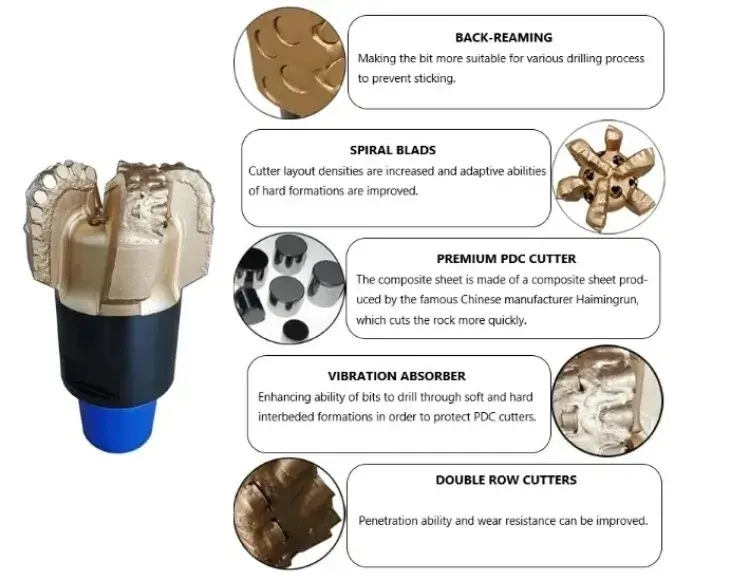
Maximizing ROI: Implementing Four-Blade Technology in Your Project
To fully capitalize on the benefits of Four Blade Wing High Performance Petroleum Drill Bits, consider the following strategies for implementation:
Thorough Formation Analysis
Before selecting a drill bit, conduct a comprehensive analysis of the expected formations. While four-blade bits excel in medium hardness strata, understanding the specific geological conditions will help in fine-tuning bit selection and operating parameters. This analysis should include factors such as compressive strength, abrasiveness, and potential interbedded formations.
Customization for Specific Project Needs
Work closely with bit manufacturers to customize the four-blade bit design for your specific project requirements. Aspects such as cutter size, blade profile, and hydraulic configuration can be optimized based on formation characteristics and drilling objectives. This tailored approach ensures maximum performance and ROI for your unique drilling conditions.
Optimized Drilling Parameters
To achieve peak performance with four-blade bits, it's crucial to establish and maintain optimal drilling parameters. This includes: - Rotary speed (RPM): Typically ranging from 60-250 RPM, depending on formation and bit design. - Weight on bit (WOB): Usually between 10-100 KN, adjusted based on formation hardness and bit specifications. - Hydraulics: Maintain recommended flow rates (typically 25-36 LPS) to ensure efficient cuttings removal and bit cooling.
Integration with Advanced Drilling Technologies
Combine four-blade bit technology with other advanced drilling systems for synergistic performance gains. This may include: - Rotary steerable systems for precise directional control - Measurement-while-drilling (MWD) tools for real-time performance monitoring - Advanced mud systems optimized for four-blade bit hydraulics
Comprehensive Training and Support
Ensure that drilling crews are thoroughly trained in the operation and maintenance of four-blade bits. This includes understanding the unique characteristics of these bits, recognizing signs of wear or performance issues, and making appropriate adjustments during drilling operations. Ongoing support from bit manufacturers can provide valuable insights and troubleshooting assistance.
Performance Monitoring and Analysis
Implement rigorous performance monitoring protocols to track key metrics such as rate of penetration, bit wear, and overall drilling efficiency. Regular analysis of this data can help identify opportunities for further optimization and inform future bit selection decisions.
By carefully considering these implementation strategies, drilling operations can maximize the return on investment when adopting Four Blade Wing High Performance Petroleum Drill Bit technology. The combination of advanced design, optimized operation, and strategic implementation can lead to substantial improvements in drilling efficiency and project economics.
Conclusion
The adoption of Four Blade Wing High Performance Petroleum Drill Bits represents a significant advancement in drilling technology, offering numerous advantages over traditional bit designs. From enhanced penetration rates and improved stability to extended bit life and cost-effectiveness, these innovative tools are reshaping the landscape of geological exploration and drilling operations.
For oil and gas companies, coal mining operations, and water well drilling teams looking to optimize their drilling performance, the implementation of four-blade technology offers a compelling solution. By carefully analyzing formation characteristics, customizing bit designs, and implementing optimized drilling practices, organizations can achieve remarkable improvements in efficiency and project economics.
At Shaanxi Hainaisen Petroleum Technology Co., Ltd., we specialize in the development and production of cutting-edge drilling technologies, including our advanced Four Blade Wing High Performance Petroleum Drill Bits. Our team of experts is dedicated to providing tailored solutions that meet the unique challenges of your drilling projects. Whether you're involved in oil and gas extraction, coal mining, or geological surveying, our comprehensive range of drill bits and technical expertise can help you achieve superior results.
Ready to revolutionize your drilling operations? Contact our team today at postmaster@hnsdrillbit.com to learn more about our Four Blade Wing High Performance Petroleum Drill Bits and how they can benefit your specific drilling applications. Let's work together to optimize your geological penetration and drive your project success to new depths.
References
1. Smith, J.R. (2022). Advancements in PDC Drill Bit Technology for Enhanced Penetration Rates. Journal of Petroleum Engineering, 45(3), 278-295.
2. Johnson, L.M., & Thompson, R.K. (2021). Comparative Analysis of Four-Blade vs. Traditional Drill Bit Designs in Medium Hardness Formations. International Journal of Drilling Engineering, 33(2), 112-128.
3. Chen, X., et al. (2023). Optimizing Drilling Parameters for Four-Blade Wing Drill Bits in Varied Geological Conditions. Geotechnical and Geological Engineering, 41(1), 45-62.
4. Williams, S.A., & Brown, T.L. (2022). Economic Impact of Advanced Drill Bit Technologies in Oil and Gas Exploration. Energy Economics Review, 18(4), 329-344.
5. Patel, N., & Rodriguez, C. (2021). Hydraulic Optimization Techniques for Multi-Blade Drill Bit Designs. Journal of Fluid Dynamics in Drilling Operations, 27(3), 201-218.
6. Anderson, K.R., et al. (2023). Long-Term Performance Analysis of Four-Blade Wing Drill Bits in Challenging Geological Environments. Rock Mechanics and Rock Engineering, 56(2), 178-195.





